Simulation Modelling for the Promotion of Green Residence Based on the Theory of Sustainability—Taking Jiangsu Province as an Example
Abstract
:1. Introduction
- Using the macro/meso/micro multi-level perspective framework of sustainability theory, different levels of complex elements, such as landscape signals for green residence promotion at the macro level, each social functional attribute of green residence at the meso-level, and consumer preferences at the micro level, are analyzed.
- Based on the macro/meso/micro multi-level complex factors derived from the analysis, an agent-based system dynamics modeling approach is used to construct a simulation model for green residence promotion.
- To determine the success conditions and the pathways to green residence promotion, the model is applied to Jiangsu Province’s green residence promotion system. Additionally, this study serves as a resource for advancing the development of green residence promotion and helps the country achieve its carbon peak and carbon neutrality targets.
2. Principles of Model Construction
2.1. Model Theory
2.2. Model Structure
2.3. Modelling Method
- Function for Generating Resources
- 2.
- Physical Capability Function of Collective Agents
- 3.
- Movement Function of Collective Agents in Practice Space
- 4.
- Motion Function of Individual Agents in Practice Space
- 5.
- Support Function of Individual Agents
- 6.
- Institutional Capacity Function of Collective Agents
- 7.
- Intensity Function of Collective Agents
2.4. Causal Loop Diagram and Stock Flow Diagram of the Model
3. Model Data and Landscape Signal Determination
3.1. Identify Institutions, Niches, and Consumers for the Model
3.2. Selection of Practice Indicators and Determination of Data
3.2.1. Selection of Practice Indicators
3.2.2. Identifying Collective and Individual Agent Locations in Practice Space
3.3. Landscape Signal Determination
4. Simulation Results
4.1. Testing of Model Validity
4.2. Simulation Results of Green Residence Promotion
- The experimental group was recognized using Section 3.3’s textual description of the landscape signals. Figure 6 displays the experimental group signals, whereas Figure 9 displays the outcomes of the simulation.
5. Discussion
6. Conclusions
- (1)
- The agent-based simulation model of the dynamics of the green residence promotion system has a good reference value for the simulation of green residence promotion. According to the simulation results of the test group in Figure 9, the development trend of various types of green residence has the same trend as the results of previous studies. The small differences in turning points and peaks are due to the inclusion of micro-individual agent consumers in the model.
- (2)
- Macro landscape signals are necessary for the success of green residence promotion. Furthermore, landscape signals indirectly promote green residences by changing the behavioral preferences of micro-individual agents. The longer the duration and intensity of the landscape signals, the faster and larger the development of high-star operationally labeled green residences, and vice versa.
- (3)
- Macro-level landscape signals are crucial for the success of promoting green residences. However, until 2035, two-star design-labeled green residences will continue to be a crucial transitional product. This is because two-star design-labeled green residences have relatively low technical requirements and incremental costs, good infrastructure, high individual agent consumer acceptance, and relatively good energy efficiency and emission reduction benefits, when landscape signals change individual agent behavioral preferences.
- (4)
- Under regular landscape signal intensity, the intensity of three-star operationally labeled green residences will reach more than 50% of the building system in 2040, becoming the regime of the building system in Jiangsu. This illustrates that the landscape signal duration and the behavioral preference shift of individual agents must be maintained for a long period of time in the process of sustainable development in the building sector in Jiangsu Province. Only in this way will the high-star green residences of the operational designation achieve a level of foundational perfection and technological advancement greater than that of the existing general residence.
Author Contributions
Funding
Data Availability Statement
Conflicts of Interest
References
- Wang, Q.Q.; Meng, C.; Zhu, R.X.; Li, J.W. Research on carbon emission of green buildings based on whole life cycle theory. Contemp. Archit. 2022, 8, 14–16. [Google Scholar]
- Zhang, K.; Lu, Y.M.; Lu, H.S. Countermeasures for the high-quality development of green buildings in China under the background of dual-carbon target. Construct 2022, 43, 14–20. [Google Scholar] [CrossRef]
- Chegut, A.; Eichholtz, P.; Kok, N. The price of innovation: An analysis of the marginal cost of green buildings. J. Environ. Econ. Manag. 2019, 98, 102248. [Google Scholar] [CrossRef]
- Chen, L.; Chan, A.P.; Owusu, E.K.; Darko, A.; Gao, X. Critical success factors for green building promotion: A systematic review and meta-analysis. Build. Environ. 2022, 207, 108452. [Google Scholar] [CrossRef]
- Song, Z.X.; Chen, L. Analysis of key drivers of green building costs. Value Eng. 2017, 36, 20–22. [Google Scholar] [CrossRef]
- Zhou, Q.; Wang, H.P.; Xue, H. Research on driving mechanism of green building development. J. Xi’an Univ. Archit. Technol. (Soc. Sci. Ed.) 2019, 38, 28–38. [Google Scholar] [CrossRef]
- Qiu, B.X. Green building development misunderstanding and promotion path. Architecture 2019, 13, 20–22. [Google Scholar]
- Yu, H.L.; Chen, J.L. Research on the risk chain of green building projects under EPC mode based on SEM. Sci. Technol. Manag. Res. 2021, 41, 199–205. [Google Scholar]
- Onat, N.C.; Egilmez, G.; Tatari, O. Towards greening the U.S. residential building stock: A system dynamics approach. Build. Environ. 2014, 78, 68–80. [Google Scholar] [CrossRef]
- Sun, G.S.; Jiang, D.L.; Feng, J.; Chen, X.X. Mechanisms of green construction technology drivers in China under the carbon peaking target: A system dynamics-based simulation analysis. Sci. Technol. Manag. Res. 2022, 42, 194–201. [Google Scholar]
- Huang, D.X.; Li, S.L.; Wu, Y.J.; Lu, R. Symbiosis between green buildings and traditional buildings with simultaneous consideration of game payment and limited market capacity. China Admin. Sci. 2021, 29, 94–105. [Google Scholar] [CrossRef]
- Park, H. A Stochastic Planning Model for Battery Energy Storage Systems Coupled with Utility-Scale Solar Photovoltaics. Energies 2021, 14, 1244. [Google Scholar] [CrossRef]
- Gao, H.; Wang, X.; Wu, K.; Zheng, Y.; Wang, Q.; Shi, W.; He, M. A Review of Building Carbon Emission Accounting and Prediction Models. Buildings 2023, 13, 1617. [Google Scholar] [CrossRef]
- Borshchev, A.; Filippov, A. From System Dynamics and Discrete Event to Practical Agent Based Modeling: Reasons, Techniques, Tools. In Proceedings of the 22nd International Conference of the System Dynamics Society, Oxford, UK, 25–29 July 2004. [Google Scholar]
- Siebers, P.O.; Macal, C.M.; Garnett, J.; Buxton, D.; Pidd, M. Discrete-event simulation is dead, long live agent-based simulation! J. Simul. 2010, 4, 204–210. [Google Scholar] [CrossRef]
- Macal, M.C.; North, J.M. Tutorial on agent-based modelling and simulation. J. Simul. 2010, 4, 6–20. [Google Scholar] [CrossRef]
- Silverman, B.G.; Hanrahan, N.; Bharathy, G.; Gordon, K.; Johnson, D. A systems approach to healthcare: Agent-based modeling, community mental health, and population well-being. Artif. Intell. Med. 2015, 63, 61–71. [Google Scholar] [CrossRef]
- Attallah, S.O. A Life Cycle Analysis Approach for the Enhancement of Sustainability Decision-Making in the Construction Industry Using Agent-Based Modeling. Ph.D. Thesis, Purdue University, West Lafayette, IN, USA, 2014. [Google Scholar]
- Jo, H.; Lee, H.; Suh, Y.; Kim, J.; Park, Y. A dynamic feasibility analysis of public investment projects: An integrated approach using system dynamics and agent-based modeling. Int. J. Proj. Manag. 2015, 33, 1863–1876. [Google Scholar] [CrossRef]
- Tran, M. A general framework for analyzing techno-behavioural dynamics on networks. Environ. Modell. Softw. 2016, 78, 225–233. [Google Scholar] [CrossRef]
- Kolominsky-Rabas, P.L.; Djanatliev, A.; Wahlster, P.; Gantner-Bar, M.; Hofmann, B.; German, R.; Sedlmayr, M.; Reinhardt, E.; Schuttler, J.; Kriza, C.; et al. Technology foresight for medical device development through hybrid simulation: The ProHTA Project. Technol. Forecast. Soc. Chang. 2015, 97, 105–114. [Google Scholar] [CrossRef]
- Zhang, Y.; Vand, B.; Baldi, S. A Review of Mathematical Models of Building Physics and Energy Technologies for Environmentally Friendly Integrated Energy Management Systems. Buildings 2022, 12, 238. [Google Scholar] [CrossRef]
- Wang, J.; Zhang, X. Sustainable energy transition: Modeling and analysis. China Popul. -Resour. Environ. 2020, 30, 74–82. [Google Scholar]
- Loorbach, D. Transition Management: New Mode of Governance for Sustainable Development. Ph.D. Thesis, Erasmus School of Social and Behavioural Sciences, Burgemeester Oudlaan, Rotterdam, The Netherlands, 2007. [Google Scholar]
- Geels, F.W.; Schot, J. Typology of sociotechnical transition pathways. Res. Policy 2007, 36, 399–417. [Google Scholar] [CrossRef]
- Geels, F.W. Technological transitions as evolutionary reconfiguration processes: A multi-level perspective and a case-study. Res. Policy 2002, 31, 1257–1274. [Google Scholar] [CrossRef]
- Chang, R.; Lu, Y. Facilitating Systemic Changes Towards Green Buildings: Developing Conceptual Frameworks of Socio-Technical Transitions. Energy Procedia 2017, 143, 31–306. [Google Scholar]
- Gibbs, D.; O’Neill, K. Building a green economy? Sustainability transitions in the UK building sector. Geoforum 2015, 59, 133–141. [Google Scholar]
- Schilperoord, M.; Rotmans, J.; Bergman, N. Modelling societal transitions with agent transformation. Comput. Math. Organ. Theory 2008, 14, 283–301. [Google Scholar] [CrossRef]
- Alex Haxeltine, L.W.; Bergman, N.; Rotmans, J.; Schilperoord, M.; Kohler, J. A Conceptual Framework for transition modelling. Int. J. Innov. Sustain. Dev. 2008, 3, 93–114. [Google Scholar] [CrossRef]
- Kong, Y.H.; Wang, L.; Guo, Z.L.; Jiang, Y.C.; Wang, B. Prediction of peak carbon emissions in Gansu Province based on system dynamics. J. Environ. Eng. Technol. 2018, 8, 309–318. [Google Scholar]
- Li, X.L.; Yin, H.P. Analysis of operational energy consumption and optimization suggestions for green public buildings in hot summer and cold winter regions. HVAC 2017, 47, 25–32. [Google Scholar]
- Liang, X.; Fu, Y. Research on the supply-side evolution game of green building under the government dynamic reward and punishment mechanism. China Manag. Sci. 2021, 29, 184–194. [Google Scholar] [CrossRef]
- Wang, Y.Y.; Chen, H.Y.; Teng, J.Y.; Ran, L.Y.; Wu, X.G. Current status and suggestions for incremental cost of green building certification program in China. J. Civ. Eng. Manag. 2017, 34, 175–179. [Google Scholar] [CrossRef]
- Wang, W.; Zhang, S.; Su, Y.; Deng, X. An Empirical Analysis of the Factors Affecting the Adoption and Diffusion of GBTS in the Construction Market. Sustainability 2019, 11, 1795. [Google Scholar]
- Wang, W.M.; Liu, A.D. Empirical study on factors influencing consumers’ green residences purchasing behavior. J. Xi’an Univ. Archit. Technol. (Nat. Sci. Ed.) 2018, 50, 454–462. [Google Scholar] [CrossRef]
- Yang, X.D.; Wu, Y.X. Factor analysis and relationship study of green residences choice behavior. China Soft Sci. 2017, 6, 175–182. [Google Scholar]
- Liu, Y.; Zhang, H. Research on factors influencing potential consumers’ green residences purchase intention. Shanghai Manag. Sci. 2017, 39, 57–62. [Google Scholar]
- Xue, F.; Zhou, X.W.; Yan, G.L.; Xu, S.T. Evolutionary Game Analysis of Green Building Promotion Mechanism Based on SD. In Proceedings of the International Conference on Economic Management and Model Engineering (ICEMME), Malacca, Malaysia, 6–8 December 2019; pp. 356–359. [Google Scholar]
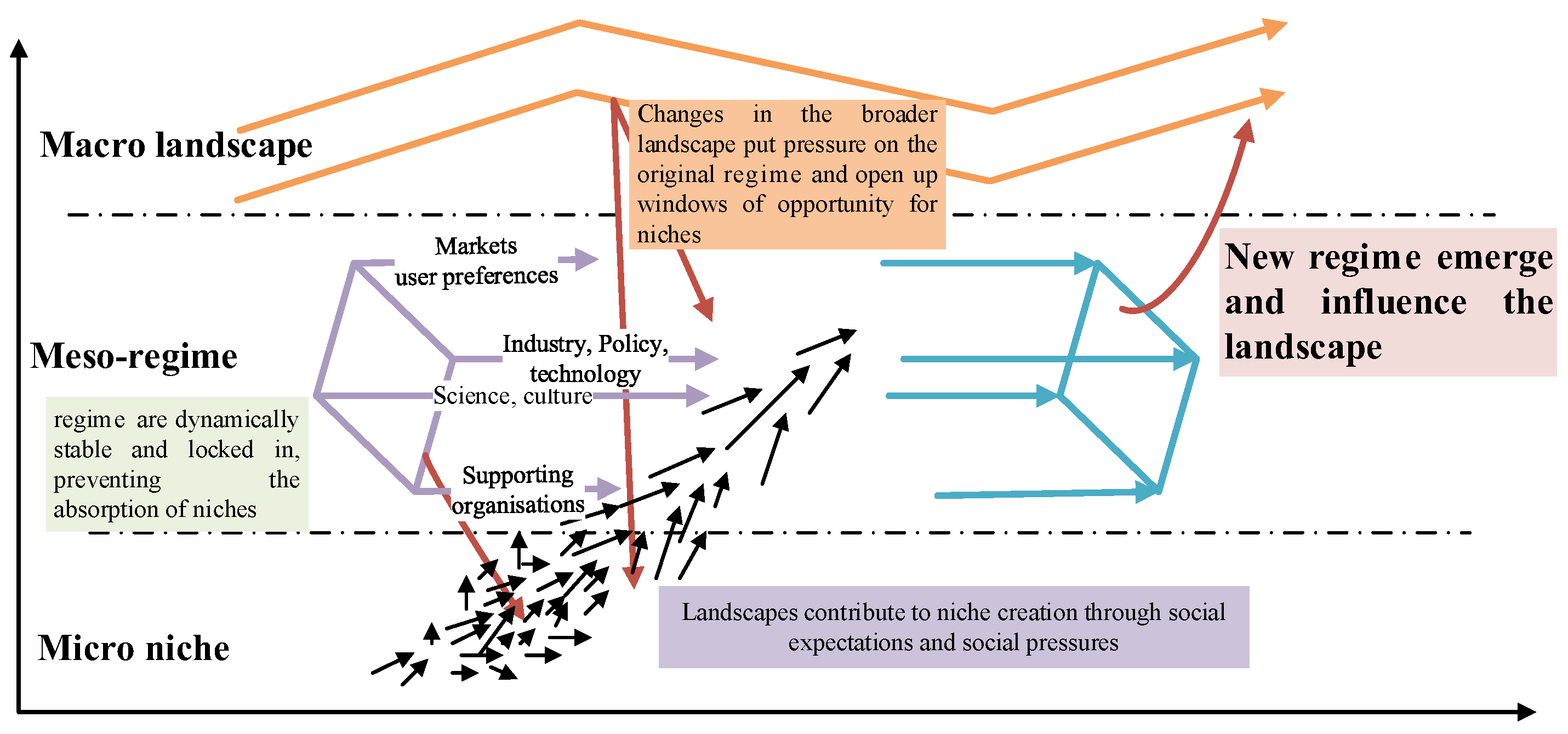
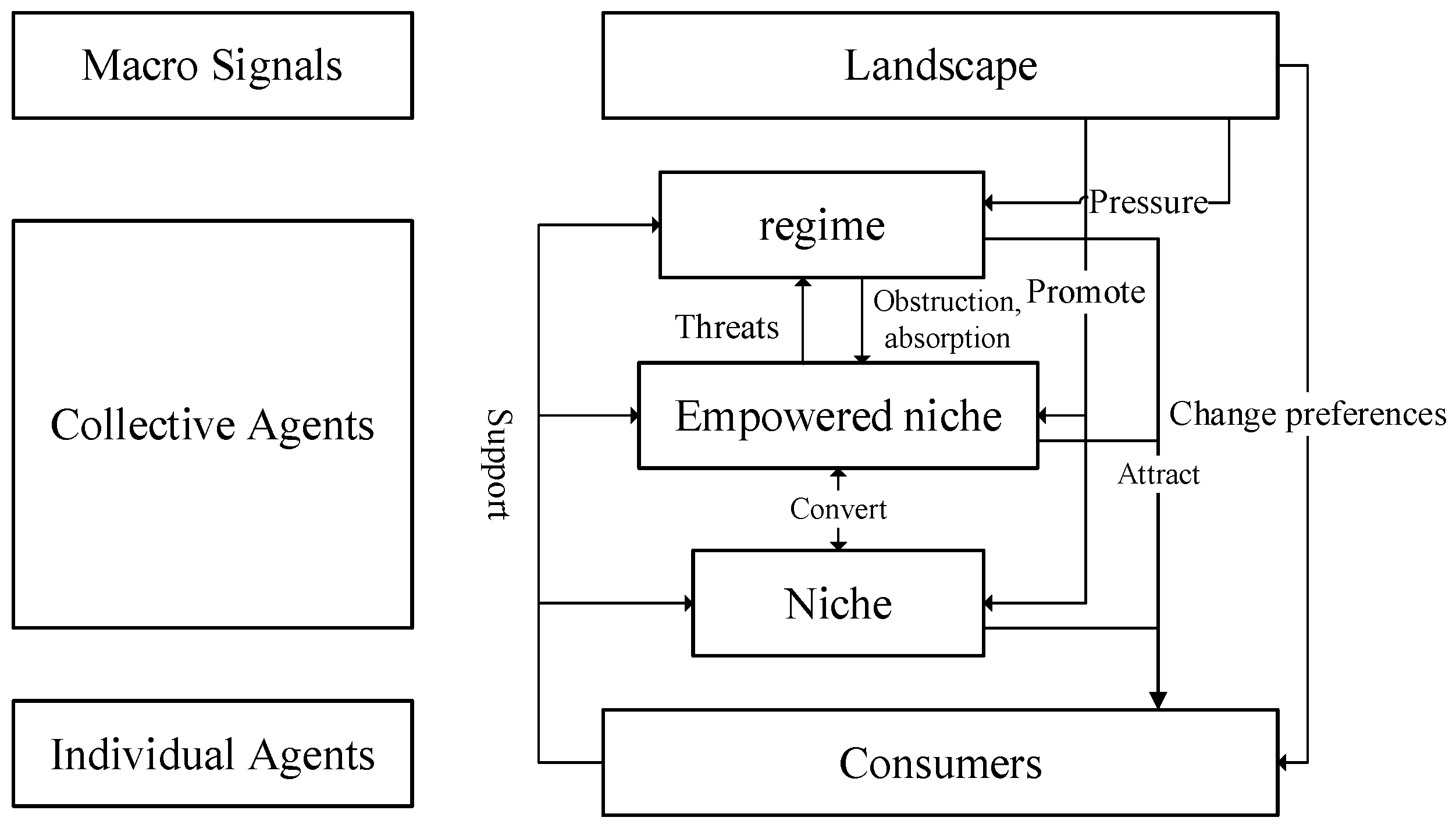
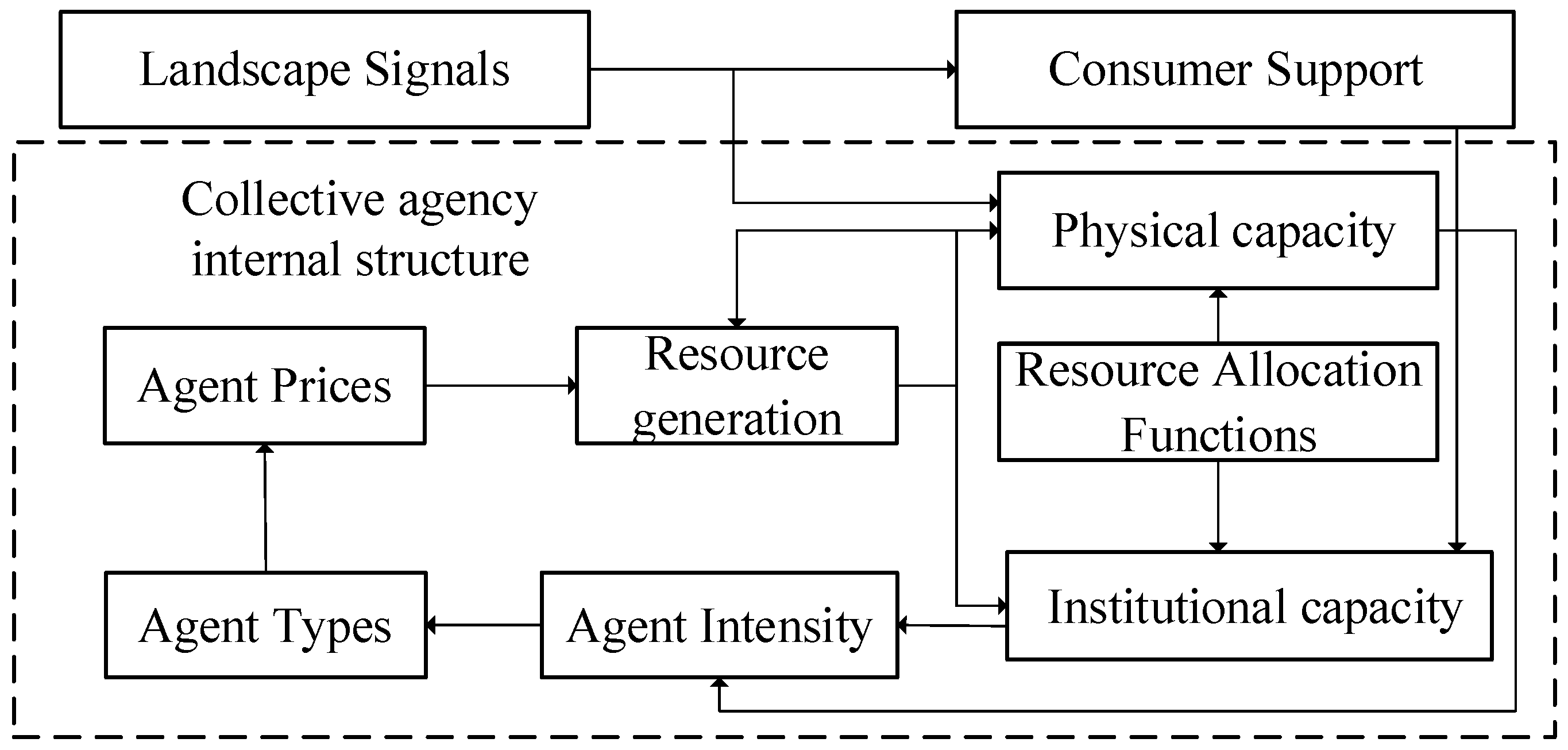
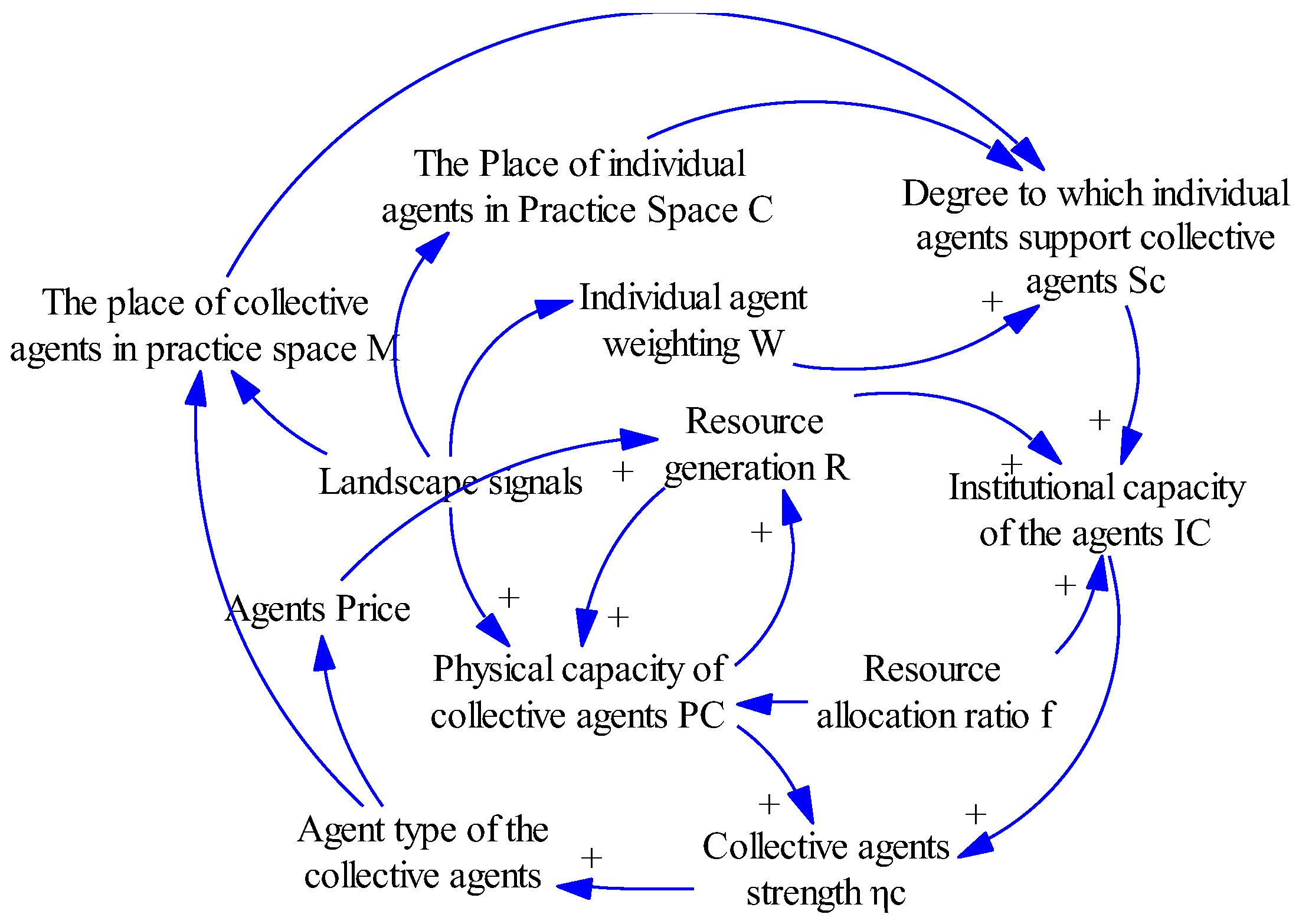

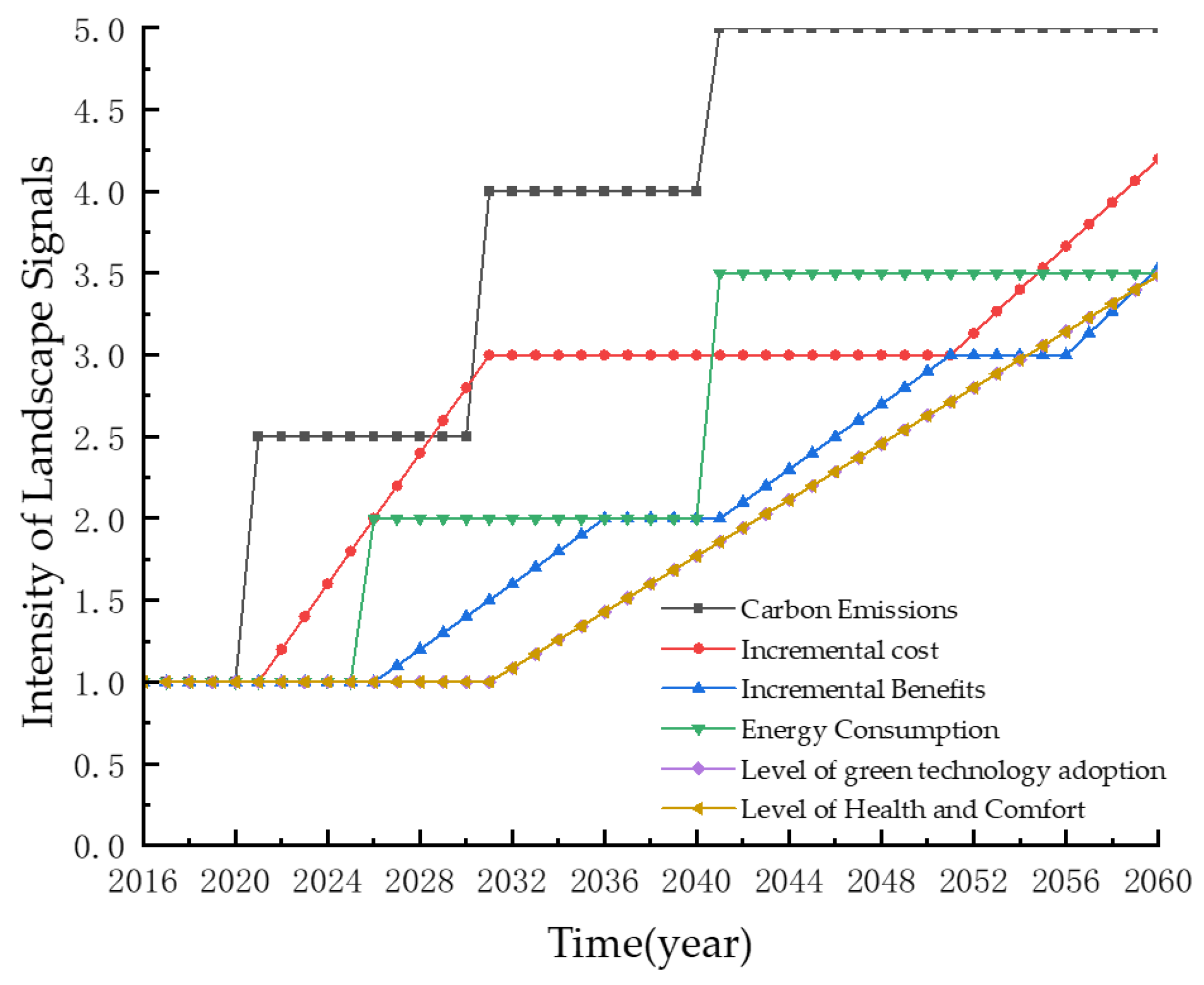
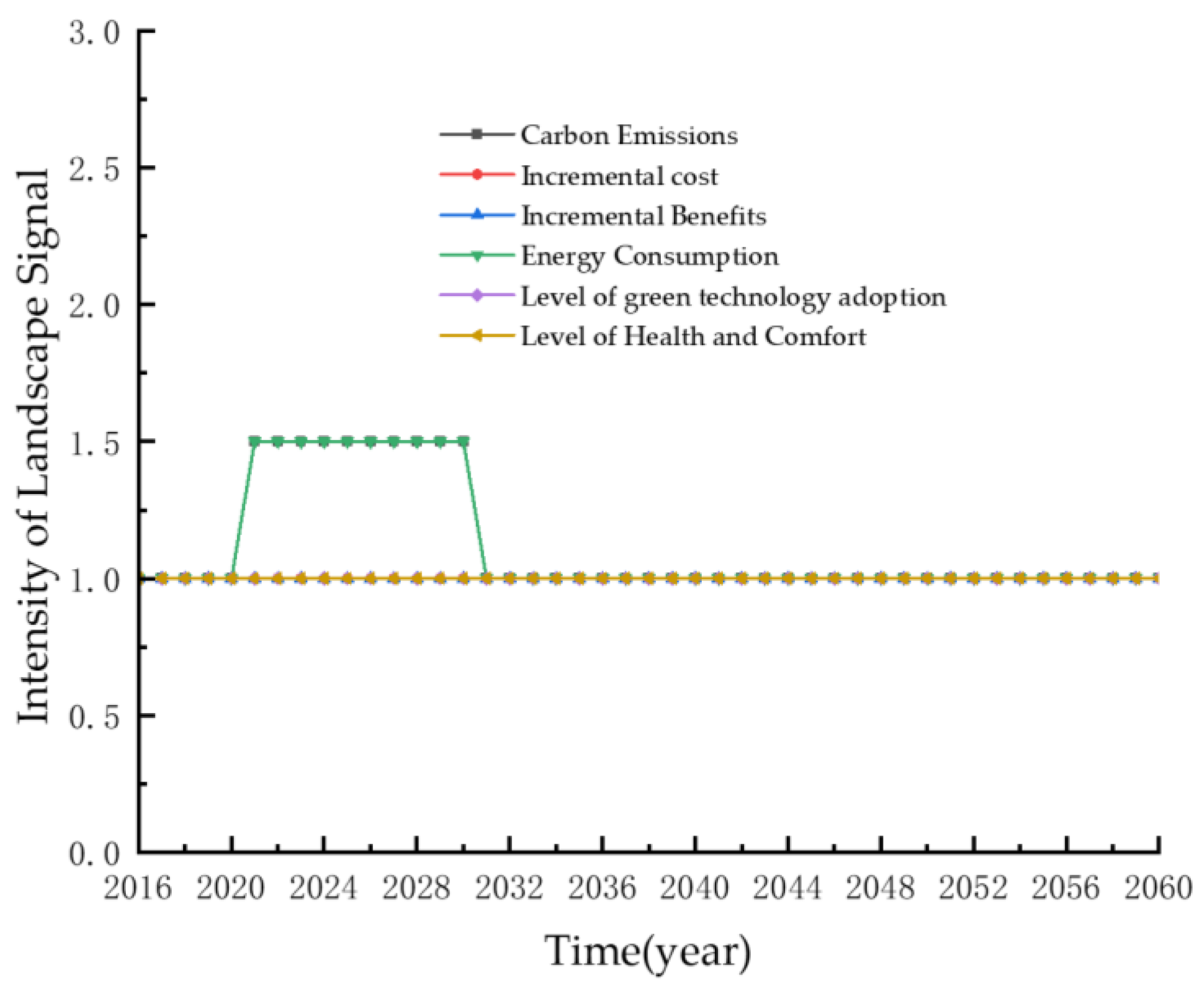


| Type of Residences | Area (Million Square Meters) | Weight of Area |
|---|---|---|
| General Residences | 15,165.22 | 85% |
| One Star Design Label Green Residences | 947.16 | 5.34% |
| One Star Operation Label Green Residences | 19.01 | 0.11% |
| Two-star Design Mark Green Residences | 1407.43 | 7.93% |
| Two Star Operational Label Green Residences | 36.69 | 0.21% |
| Three-star Design Label Green Residences | 136.25 | 0.77% |
| Three Star Operational Label Green Residences | 28.24 | 0.16% |
| Carbon Emissions | Incremental Cost | Incremental Benefits | Energy Consumption | Level of Green Technology Adoption | Level of Health and Comfort | |
|---|---|---|---|---|---|---|
| Regime | 100 | 0 | 0 | 100 | 5 | 5 |
| Niche 1 | 49.29 | 19.44 | 31.54 | 54.19 | 35 | 30 |
| Niche 2 | 60.85 | 9.42 | 12.74 | 76.34 | 15 | 15 |
| Niche 3 | 29.71 | 57.73 | 56.37 | 23.38 | 50 | 65 |
| Niche 4 | 44.77 | 20.66 | 17.51 | 59.56 | 30 | 45 |
| Niche 5 | 32.82 | 44.50 | 46.71 | 39.15 | 65 | 85 |
| Niche 6 | 0 | 100 | 100 | 0 | 85 | 100 |
| Individual Agent Type | General Residential Customers | Green Residential Customers |
|---|---|---|
| Carbon Emissions | 90 Approaching regime’s carbon footprint | 45 Near Niche 1’s carbon emissions |
| Incremental Costs | 0 The regime’s incremental cost is the same | 15 Increasing expense of entering a specialty |
| Incremental Benefits | 0 Having no incremental advantage over the regime | 40 Added advantages of going after Niche 5 |
| Energy Consumption | 85 Closeness to the regime’s energy use | 35 Energy use in the vicinity of Niche 5 |
| Level of Green Technology Adoption | 5 Adoption of green technologies at the same level as the regime | 30 Adoption of green technology at the same level as that of Niche 1 |
| Level of Health and Comfort | 5 The same level of comfort and health as the program | Health and comfort level 35 Slightly above the Niche 5 |
| Consumer Weighting | 0.7 | 0.3 |
| Vintages | Relative Tolerance | ||||
|---|---|---|---|---|---|
| 2016 | 2017 | 2018 | 2019 | 2020 | |
| Regime | 1.90% | 4.20% | 5.24% | −3.08% | 2.71% |
| Niche 1 | −4.14% | −2.50% | 6.28% | 0.35% | −6.46% |
| Niche 2 | 2.46% | −3.79% | 1.66% | −3.23% | −0.94% |
| Niche 3 | −4.58% | −6.48% | 1.78% | 5.39% | 0.88% |
| Niche 4 | −0.47% | −2.72% | −8.98% | 0.00% | 0.00% |
| Niche 5 | 9.25% | 9.64% | 6.47% | 0.90% | 2.91% |
Disclaimer/Publisher’s Note: The statements, opinions and data contained in all publications are solely those of the individual author(s) and contributor(s) and not of MDPI and/or the editor(s). MDPI and/or the editor(s) disclaim responsibility for any injury to people or property resulting from any ideas, methods, instructions or products referred to in the content. |
© 2023 by the authors. Licensee MDPI, Basel, Switzerland. This article is an open access article distributed under the terms and conditions of the Creative Commons Attribution (CC BY) license (https://creativecommons.org/licenses/by/4.0/).
Share and Cite
Xu, H.; Zhang, J.; Xu, X.; Zeng, Z.; Xu, Y.; You, J.; Li, J. Simulation Modelling for the Promotion of Green Residence Based on the Theory of Sustainability—Taking Jiangsu Province as an Example. Buildings 2023, 13, 2635. https://doi.org/10.3390/buildings13102635
Xu H, Zhang J, Xu X, Zeng Z, Xu Y, You J, Li J. Simulation Modelling for the Promotion of Green Residence Based on the Theory of Sustainability—Taking Jiangsu Province as an Example. Buildings. 2023; 13(10):2635. https://doi.org/10.3390/buildings13102635
Chicago/Turabian StyleXu, Hao, Jun Zhang, Xizhen Xu, Zewei Zeng, Yuzhu Xu, Jiawei You, and Jing Li. 2023. "Simulation Modelling for the Promotion of Green Residence Based on the Theory of Sustainability—Taking Jiangsu Province as an Example" Buildings 13, no. 10: 2635. https://doi.org/10.3390/buildings13102635
APA StyleXu, H., Zhang, J., Xu, X., Zeng, Z., Xu, Y., You, J., & Li, J. (2023). Simulation Modelling for the Promotion of Green Residence Based on the Theory of Sustainability—Taking Jiangsu Province as an Example. Buildings, 13(10), 2635. https://doi.org/10.3390/buildings13102635





